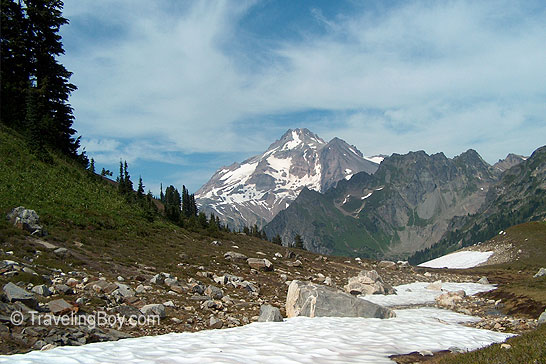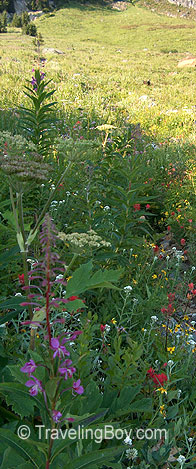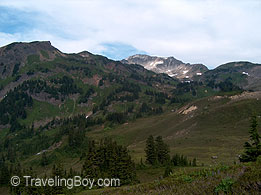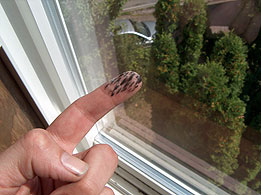 |
 |
|
 |
|
Glacier Peak I Will Destroy You |
 Glacier Peak money
|
|
I've always had my eye on Glacier Peak. It just
sounds cool. Glacier laden valleys fiercely guarding an ice
rimed, wind swept cap, a challenge for all seasons. Heck yes.
Before I had moved from the northwest to California, it was
one of the few northwest peaks I had desired to climb but hadn't
gotten to. When I moved back six years later in 2005, it was
pretty much Job #1 on my mountaineering list, so I did a bit
of internet research and headed up there. The last successful
climb I had seen posted had been from a couple of years previous,
but this was only mildly puzzling. I figured that this fact
meant good things for me since there were probably very, very
few people climbing it year to year, and I like being alone
on a mountain. When I got to the ranger station in Darrington,
a map displayed prominently on their cork board outside the
building declared only bad news. The rangers had painted a red
line around a full three quarters of the whole mountain, denoting
no access. Much to my surprise, I found out that spring flooding
in 2003 had wiped out almost every road approach, many trailheads,
and large sections of individual trails. I hadn't heard a thing
about it. Over ten inches of rain had fallen in October of that
year, and the resulting deluge caused Glacier Peak to shed itself
of most of its paved approaches, bridges, trails, and campsites,
and in so doing, made itself effectively inaccessible. So bad
was the devastation, a ranger informed me that the Forest Service,
a full two years later, still had almost a dozen vehicles trapped
up in the mountains beyond the washed out bridges and roads.
She stated that the only way to retrieve them would be by helicopter,
which meant they would probably stay until The Rebuilding, as
that recovery option was way too expensive. She also had no
guess as to when the infrastructure would be repaired. Looking
on the map, I found that the nearest available approach would
be a full (35 mile) roundtrip slog from an exotic southeasterly
approach. I was not mentally prepared for that, and also didn't
have the time on that particular trip. Instead, to console myself,
I drove into Canada for the afternoon, and ate like five donuts
at a Tim Horton's, which almost fully assuaging my fluttering
pangs of disappointment.
In 2006, a particularly brutal work regimen kept me postponing the climb until late September. The weather had been remarkable each weekend, so I was greatly anticipating my attempt. When I finally had a free weekend, the weather turned sour the very Friday morning I was to leave. Clouds descended from the heavens, and from then on for the rest of that year the mountain was entombed in snow and ice. Aha! So here we are in 2007, when my climb would
certainly be an inevitable success. In August, I took five days
off and planned three for the climb attempt. Leaving from Seattle,
it was about a two hour drive to the trailhead, the last ten
miles of which was very decent Forest Service dirt road. Thankfully,
the last five miles of this road had just opened up from the
2003 flooding event the previous week. As is somehow my custom,
I arrived at the North Fork Sauk trailhead in mid-afternoon,
around three o'clock. There were about ten cars there. Thankfully,
late as I was, as soon as I pulled into my parking space, I
saw a couple straddled with huge backpacks that were just heading
out toward the trailhead, which made me feel a bit better.
Much of my concern on this trip was to whether
or not I needed crampons. I thought about that a lot, both before
and during the trip. Crampons are dang heavy, so you mentally
weigh very carefully before a trip whether you need them or
not. If you bring them and don't need them, it makes you angry
to think about having carried them the whole way for nothing.
Aggravating. On the other hand, if you encounter a steep field
of snow and ice in the last 200 feet to the summit and don't
have them, you're risking your life to press on without them.
I asked the young fresh fellows whether they had brought any
or not, and these dang kids said no, they didn't bring them
and hadn't needed them. They said they saw some other climbers
using them close to the summit though. (Undoubtedly, all these
climbers were 36 years old, I internally reckoned.) At this
moment, I could feel the extra weight of the crampons in my
backpack slowly sinking my ankles into the soil of the trail
I was standing on. I nearly had to adjust my stance to avoid
sinking straight to the center of the earth. Aaargh. Anyway,
those cool kids were off and I was all the better for having
bumped into them, and vastly encouraged about my chances of
making the summit. With one of them throwing a determined fist
toward the sky, they departed with an enthusiastic, single-word
battle cry: "Denny's!" A few hours later, my worst fears came to pass. At the same instant, a mountain lion and a brown bear pounced through the thin walls of both sides my tent, intent on gorging themselves on fattened Seattleite. Instead, surprising each other, they both got into a fight and rolled down the ridge together in a furious fightball, not to be seen again. Ok, that part didn't really happen…. The next morning I got going at around 8:00,
which is a big change from the usual 3:00 am summit bids I'm
used to, having to get up early to avoid the sun melted snow
that leads to insane-making "post hole" hiking. Several
pictures I found of the mountain online taken during summer
months showed a virtually snow free approach on the south shoulder
of the mountain. I packed up and viewed my approach choices.
The first was to hug the elevation line to the east and end
up in the area where I had seen the alpine lakes the night before.
This choice, according to what I could see on the map, would
have me going completely off trail but at least I could hug
the elevation line and not have to endure the body punishment
of a lot of elevation gain and descent. The second option was
to follow the Pacific Crest Trail (PCT) northward, down to Baekos
Creek and hike up the river canyon to the summit. In the midst
of this decision making process, there was a problem. I had
heard about a forest fire that had developed to the east on
the radio the day before, and a thick haze had already filled
the air that morning, which meant I couldn't see any great distance
in detail to plan my alpine lakes approach. I decided I had
better stick to the trail on this particular day because of
the visibility. If I hiked up the river canyon, I could always
just turn around and bump right back into the PCT if things
didn't go right.
As soon as I hit the trail, I noticed a lone
figure approaching from the valley below. Excellent. When you
run into someone in a wilderness area, it's different than just
running into someone on the sidewalk. Out in the nether-zones,
when a meeting occurs, there before you is a human being who
has planned for a long time to be in the middle of nowhere,
just like you, and has paid the logistical and physical costs
to get there. And you know that each has a predictably burly
heart if his willingness has been followed with the action to
be standing right there in front of you. With anticipation,
I headed down to see who this one might be. It ended up being
a guy in his early thirties with a huge backpack, wearing a
do-rag on his head which was covered in mosquitoes. He said
he was toward the end of a seven day hike, and was dirty, stained,
and cut up from having to bushwhack through a still unimproved
section of the PCT damaged by the floods. It was a joy to see
him, as he had already endured several times the suffering that
I would during my whole trip, and his face bore hardened but
satisfied testament to the rewards of that type of excursion
into the deep. The hike back up the PCT to my tent was quite
a grind, and by the time I reached camp, I was pretty dang tired,
realizing I'd already been hiking for almost eight hours. When
I arrived I was relieved to see that no marmot or even bigger
animal had chewed through my tent to get to the remainder of
my food inside, and I sat down on a rock overlooking the valley
I had just hiked through, hoping to rest a bit, and also hoping
that the severity of the ridgeline would concentrate enough
wind to keep at least the mosquitoes at bay. I was wrong. So
horribly, horribly wrong. There was indeed a breeze that would
have kept any city bugs away, but these were wilderness mosquitoes,
and I was probably only the second hiker they'd ever seen in
their lives, and there was no do-rag to separate them from my
lovely, blood rich scalp. Looking behind me, I could see tens
of mosquitoes fighting furiously to cross over into my wind
shadow and wildcat their mining drills into my rich oil fields
of Dutch blood.
The next day was passed experiencing the life of a cripple. Every time I got up from the couch, I had to move gingerly for two full minutes before my legs would work correctly. A look in the mirror offered a face rimmed with around 25 mosquito and black fly bites. Including other body parts, I counted around 70 bites all together. I also picked up some sort of odd alpine birthed fungus on my left index finger, which stuck around for some time. The next day offered much of the same hobbling and itching, until eventually all things normalized. I will destroy you, Glacier Peak. All of these
sufferings over the last three years will equate to nothing
but success at the apex of your lofty, ice and rock encrusted
crown. You will feel the bottom of my feet grinding down on
the top of your head, and I will be exalted as I stand there,
and you will be brought low. Returning home from my conquest,
I will write your name on my ice axe with a black Sharpie, right
next to all the other victims. Then I will ignore you, my noble
boot not setting foot on your soils for the rest of my God-given
life, unless one of my prodigious offspring would like to vanquish
you just as I have, with my Napoleonic tutelage guiding their
every step, until you are, once again, mounted like a lowly,
load bearing donkey… |
Jeem! Found ur Glacier trek (I will Destroy You Glacier Peak) to be serious kick ass. To be honest, I’m such a lightweight, I’ve never been more than a day tripper. When u really get out there on one of those long solo treks, and the water runs short … can u drink from local streams? I’ve heard that pollution is so bad that even places untouched by man are now off-limits.
VitoZee Howdy VitoZee,
Great to hear from you and thanks for the complement and question. That is a seriously cool name, by the way: VitoZee. Just from the phonetics of it, I get the impression that you might be a very friendly and mild-mannered hitman working out of North Jersey. Really cool.
As for your drinking water from streams question, there are a lot of answers for it. The simple answer is that, no, you can almost never implicitly trust stream water sources, unless they are flowing straight out of the ground (via an aquafer or spring) bubbling up right there in front of you. That's your best bet, but you rarely see that in the wild unless you're looking for it, and even so, I have actually gotten sick from drinking spring water straight from the source at Panther Springs on Mount Shasta. You never know what you're going to get drinking untreated water from the wilds.
Most of the time the pollution you'll be dealing with out in the wilderness is not man-made, it usually comes from bacteria and parasites that inhabit the bodies of wilderness animals. For example, on this Glacier Peak trip, I drank from a stream I was confident was trustworthy. In the immediate vicinity were living quite a few marmots. A number of days after I got home I fell ill, and had to wonder if I hadn't picked up something from the water I drank, as there was not much of any other explanation for my symptoms. I knew a trip to the doctor would probably result in them sending me back home with a plastic cup that was required to be filled with my own poo, which would need to be delivered back to the lab steaming hot so they could figure out exactly what kind of bacteria or parasite they were dealing with. (Not a joke, remember Panther Springs?) After this diagnosis, I would then have to go back to the doctor and get a prescription, but by then, my body would have probably fought off the tiny invaders completely on its own. Not worth the trouble, and all of this would certainly = Jim minus $280. So I suffered it out, and whatever happened to be bothering me left my system in about 7 days or so. Yuck. No fun.
Anyway, I don't recommend drinking straight from the streams of the wild, but in a pinch, I do it everytime, unless I see a bear or a moose straight upstream from me pooping in the river, which has only happened about ten times. (Or zero times.) Anyway, sometimes I get sick, sometimes I don't. If I'm exhausted and thirsty, to heck with it, I'm drinking it.
All this notwithstanding, or withstanding, or notwithoutstanding, whatever, they just recently invented the coolest thing in the world though, so you might want to check it out. Previously, for treating your water in the wild, you'd always have to put a pellet of iodine or a congregate of other evil ingredients into your jug of stream water and let it sit there for an hour before you drink it while the chemical cocktail thoroughly treats your water. That is ridonkulous because when you're hiking and thirsty, you aren't going to wait a full hour for that pill to dissolve and work properly, you are going to guzzle. Anyway, they just invented this magic wand of sorts that you can find at any decent backpacking or outdoors store. You turn it on and dip it in your stream filled water jug, and the ultraviolet light it produces irradiates everything to death on the spot, after about 30 seconds or so. Kind of like my pinky finger, which I keep forgetting to treat my stream water with, because I'm always so dang thirsty.
Jim
 |
![]()
Jim decides to do Victoria on a whim.
This site is designed and maintained by WYNK Marketing. Send all technical issues to: support@wynkmarketing.com
|
Glacier
Peak Tips 1.
Plan to suffer. 2.
Plan on being there long enough to summit. 3.
Choose your summit route carefully. 4.
Save weight.
|






























